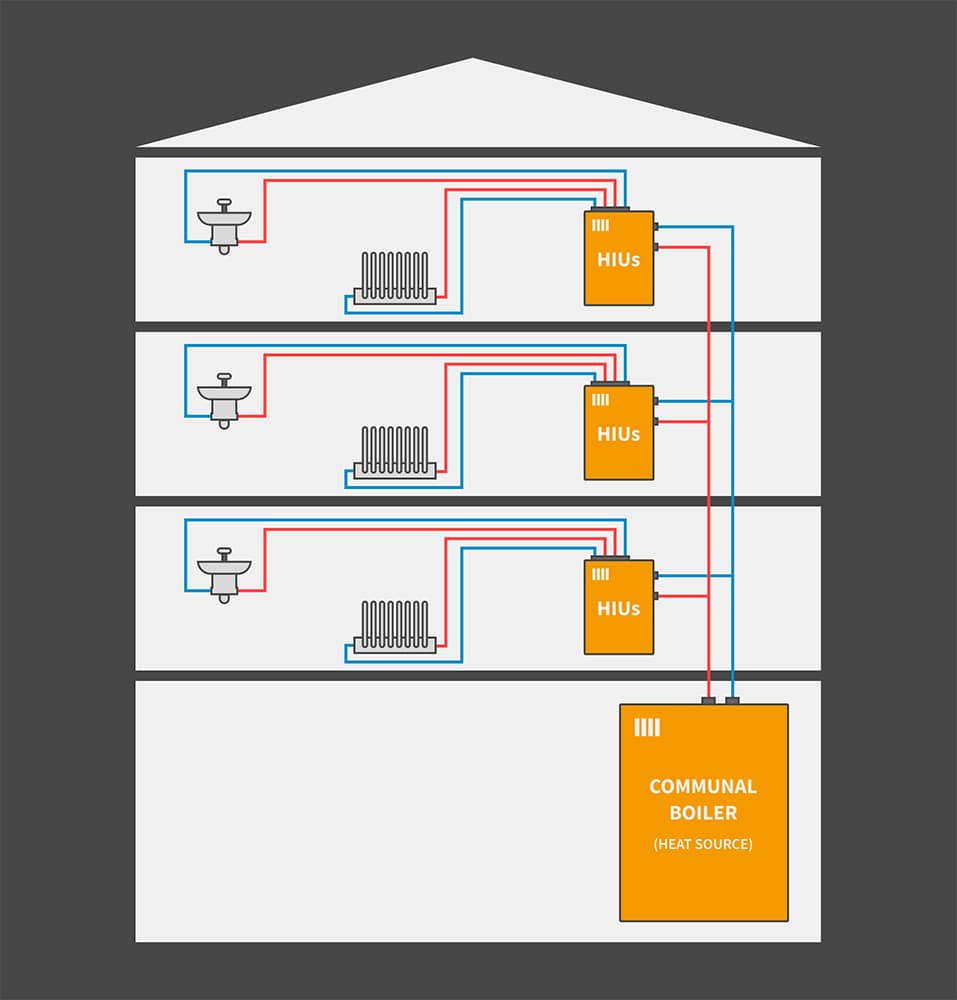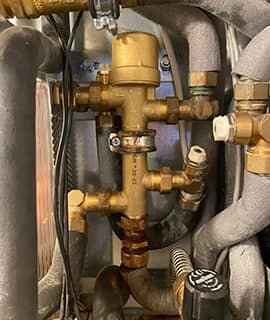Heat Interface Units (HIUs) are still considered a niche heat solution in many UK locations due to their use in communal residential dwellings only. However, in London and other large cities where blocks of flats are plentiful, HIUs are becoming very relevant.
Oliver Osmore, Director at London plumbing and heating firm, Maintracts Services, explains what heat interface units are and how they came to be, and covers some of the benefits of using them in blocks of flats and apartments. Our boiler installation team is also available to assist with any related needs.
What is a Heat Interface Unit (HIU)?
In a bid to eliminate the safety risk and energy inefficiency of having an individual gas boiler in every individual flat within a block, or the old-style communal heating systems, many new build flats are opting for HIUs to heat the building instead.
The principle behind heat interface units is they utilise a communal heat source and serve as a bridge between the central boiler and the heating and hot water systems of each residence within a block of flats. Simply put, a heat interface unit is a piece of equipment which transfers heat from a communal heat source to the heating and hot water systems inside any individual dwelling. An HIU is equipped with a heat meter which measures the amount of heat utilised by each resident, which is why they are a popular choice in modern blocks of flats.

How do HIUs work?
Heat interface units operate like so:
Let’s assume you live in a block of 100 flats. There will likely be one (or two) communal boilers down in the plant room which serves as the communal heat source. Each individual flat has a pair of primary pipes flow and return pipes) which at one end connect to the communal boiler system, then branch off and connect to the heat interface unit inside each individual dwelling.
HIUs are often referred to as heat transfer units because that is exactly what they do – they act as an interface for transferring heat from the communal heat source to the heating and domestic hot water systems inside each property.
To do this, there is one or two heat exchangers inside the heat interface unit. The unit has the communal heating pipe running through one side of the heat exchanger. The water for the heating or hot water system then passes through the other side of the heat exchanger ready to be used for heating or hot water purposes by the resident. As a result, the heat has successfully been transferred from one medium to another.

The graphic above shows the communal boiler (heat source) in the basement of a block of flats forming the source of a heating circuit. The flow and return pipes (blue and red pipes) lead up from this source to feed the HIU in each property. The HIU transfers the heat from the communal heat source through to the heating and hot water services inside the property.
How did HIUs come to be?
Heat interface units have only seen significant growth in recent years owing to their improved functionality and ability to control each property within a communal block independently.
Historically, communal heating systems tended to be less efficient. Electric panel heaters for example, produce an oppressive heat, storage heaters are not very user friendly and are primarily designed for properties that have Economy 7, and older communal boilers which pass directly through all the radiators within a block of flats are very inefficient. If you are using significantly less hot water and heat than your neighbours but the energy is split equally between all residents (because there is no way to measure individual usage), that is not efficient – let alone fair!
Heat interface units came onto the market as a solution that is almost comparable to having a gas-fired combination boiler in each property. Offering the ability to control and measure heat usage for each property within a communal block of flats independently.
The (plate) heat exchanger that resides inside an HIU which I mentioned earlier, works in the same way as a combination boiler whereby you turn on your tap, the boiler fires up, generates heat, and within a minute you have hot water coming out your tap. An HIU doesn’t even have to fire up; when you turn on the hot tap, the pump turns on in the unit, it circulates heat from the communal system, your mains water passes through the other side of the heat exchanger and is heated up instantly. So, it’s the same principle that a combination boiler utilises, it simply uses a communal heat source rather than gas.
What are the benefits of using HIUs?
Limits gas filled pipework
In an old-style communal gas heating system with a block of flats, each flat would need its own gas supply. Running a gas supply, potentially a long way through a building will present a risk. The more pipework there is, the more likely there is to be a leak and the more pipework there will be to maintain and repair.
Energy efficiency
HIUs allow for efficient heat distribution, ensuring that the heat generated in a centralised system is utilised effectively in individual dwellings. This can lead to energy savings compared to decentralised heating systems. They offer great flexibility and functionality for the end user because they can be adapted to the unique heating and hot water requirements of each individual flat within a block.
Reduced maintenance
Centralising the heat generation and maintenance in a community residential setting can reduce the maintenance workload for individual property owners, as the responsibility for maintaining the central heat source falls on the landlord or block management company. That said, HIUs still do need maintaining as they can still develop problems in a similar way to a combination boiler. In some respects it is more important to have them maintained annually as if they get out of balance they can stop performing and operating satisfactorily.
Stable heat supply
HIUs ensure a stable and consistent supply of heat and hot water to individual properties, eliminating the fluctuations in temperature that can occur with decentralised heating systems.
Produce a good flow rate of hot water
In terms of hot water, HIUs produce a very good flow rate of hot water. For example, with some combination boilers, trying to fill up a bath can take time because running the tap too quickly can mean the water starts to go tepid. This is especially true with older boilers.
In comparison, the heat interface unit has a good capacity for heating water and therefore keeps a good continual flow.
Easy monitoring and control
HIUs can be equipped with smart technology for remote monitoring and control, allowing for efficient management of heat distribution and consumption. This can lead to further energy savings and optimised performance.
Compliance
In many cases, the use of HIUs might be encouraged or mandated by building regulations and energy efficiency standards, ensuring compliance with local laws and regulations. They also offer greater prevention against fires – another reason why the use of gas is not permitted in communal flats.
Are there any negative aspects of HIUs?
The main challenge with HIUs is often associated with availability of parts. Heat interface units are generally imported from abroad and are adapted for use in the UK. There isn’t particularly good technical support or after sales service from the 80 installers and BETA manufacturers. Therefore, in the industry, there are a lot of engineers who are unwilling to work with them. We have niche team of engineers at Maintracts who are trained to work on HIUs and have successfully repaired and serviced systems.
They are generally a reliable system, but if they do go wrong, they can be more difficult (and time consuming) to repair in comparison to a combi boiler. The parts are also typically more expensive and, therefore, they can be more expensive to repair too.
Like regular boilers, HIUs need regular checks. A common cause of leaks is from PM valves like this one we fixed, serviced, and tested for a customer:




We investigated our customer’s hot water pressure and flow throughout their property after they had experienced poor performance for 6 months! We found a repair was required on the heat interface unit and combined unvented cylinder. No more pressure problems:

Can HIUs be installed within an existing communal boiler system?
The communal system needs to be set up for heat interface units. If you are in a block of flats with an old, communal heating system, one resident couldn’t decide to have an HIU – it wouldn’t work. In this scenario, the whole system would need to be upgraded at the same time.
Heat interface units can be used to heat multiple dwellings efficiently and effectively, meeting occupants’ heating and hot water needs via a central energy source. To speak directly to a member of our professional heating team about HIUs please call 020 868 22244.


